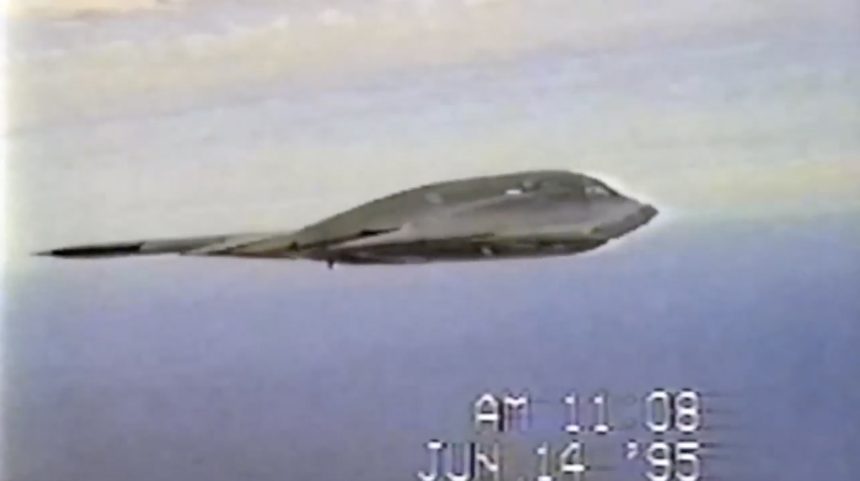Test Video Shows Interesting Structural Capabilities of Advanced Aircraft Like B-2.
This remarkable video of a Northrop Grumman B-2 Spirit stealth bomber undergoing wing flutter testing on June 14, 1995 is fascinating for a number of reasons.
All aircraft wings have a remarkable capacity for flex. But one of the most significant changes in aircraft engineering in the four decades or so has been the addition of composite materials, especially carbon fibers, into aircraft structural design. In many cases these composite materials have replaced metal alloys in structural components on advanced aircraft.
The B-2 Spirit is approximately 80% composite, mostly carbon fiber. Some of the structural framework internal to the B-2, especially where the wing blends into the fuselage and the largest fuel tanks are located, is titanium and aluminum. There are many reasons composite materials, or materials made up of a combination of advanced materials including metals, polymers (plastics) and carbon atoms at the most elemental level, have become so common in aviation engineering.
Some of the reasons are also illustrated in this video, that shows “aeroelastic flutter”.
What’s Aeroelastic flutter?
Aeroelastic flutter is a type of instability that can occurs in aircraft (in structural components like wings, tail, and control surfaces) and other structures that are subjected to aerodynamic forces resulting in oscillations that can grow in amplitude and potentially lead to structural failure.
Aeroelastic flutter is typically prevented through careful design and analysis of the structural and aerodynamic properties of the system, as well as through the use of damping devices such as control surfaces and dampers. However, it can still occur in some cases, particularly if the aircraft is subjected to unusual or extreme conditions, such as high speeds or gusty winds.
Composites Are Anisotropic.
Anisotropic materials can be engineered to transmit energy differently in different directions. Metals, including metal alloys like aluminum made from the ore bauxite, are isotropic, transmit strain in all directions.
A composite like carbon fiber, being anisotropic, can be engineered to be stiff along one axis or direction of stress, but flexible in another. In the case of the B-2, the carbon-fiber composite material in the wings is engineered to absorb energy from aerodynamic stress and bend significantly in the vertical axis, with little change in flight attitude during the flexing. The wings do not twist or begin a similar leading edge to trailing edge vibration, which would change the aircraft’s angle of attack.

Composites Have Different Fatigue Characteristics.
Eventually all materials fail. The number of normal fatigue cycles a material can endure prior to failure is part of its fatigue limit. In general, isotropic materials like metals and metal alloys have a shorter, lower fatigue limit or number of fatigue cycles. Composite materials like carbon fiber can be engineered at the molecular level to have much longer fatigue limits, enduring more fatigue cycles. And when they reach their fatigue limits, composites tend to fail differently than metals, with cracks propagating through the laminated material very differently than through the often more linear grain structure of a metal or metal alloy. As a result, carbon fiber structures in aircraft can be more durable than alloy structures, one of the reasons for the growing use of carbon fiber composites in advanced aircraft like the B-2 and in future aircraft like the B-21 Raider.
B-2s also have a system called the Gust Load Alleviation System that looks like the aircraft’s beaver tail. The GLAS counters the rolling impact or resonance to smooth out the ride of the B-2 in turbulent conditions and extend the aircraft’s fatigue life. The GLAS also smooths the ride of the B-2 in low altitude flight, even though the B-2 is predominantly designed for the high-altitude flight regime.
Air Force test data from tests like the one in this video and through finite elemental analysis (FEA) modeling suggest the B-2 will remain structurally sound to approximately 40,000 flight hours. This analysis also revealed that the rudder attachment points at the B-2’s wingtips are the highest structural stress areas and will be the first to fail. B-2 Spirits have not implemented an Aircraft Structural Improvement Program (ASIP) as we have seen on the primarily alloy B-52 heavy bombers. Some sources suggest this may make it more difficult to predict an economic service life and attrition rate according to author Don Greer. Given the current engineering limitations established in tests like these, the current B-2 Spirit force will fall below its requirement of 19 aircraft (of which less are combat capable) by the year 2027, making the new B-21 Raider even more important.










